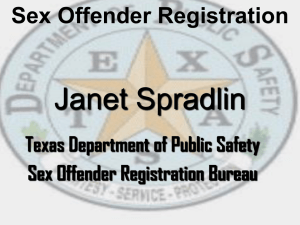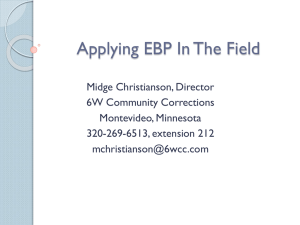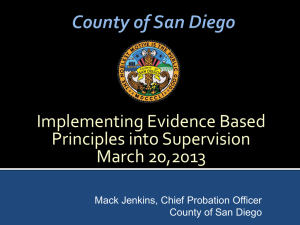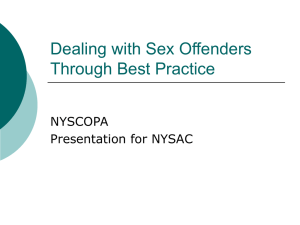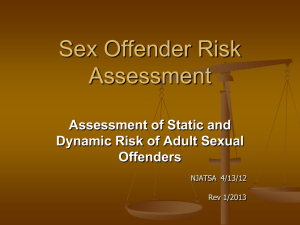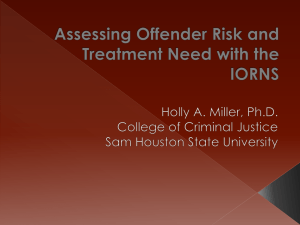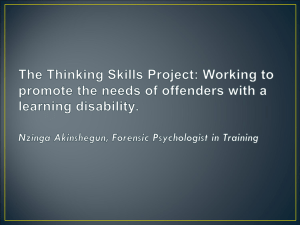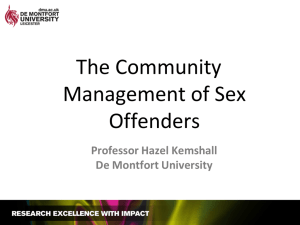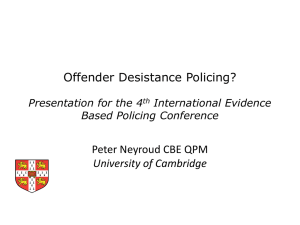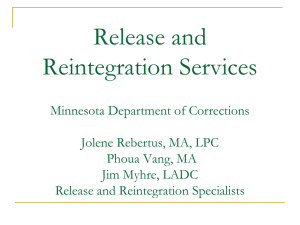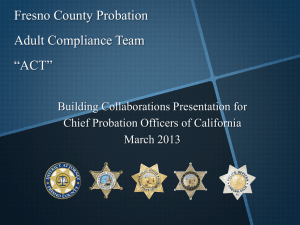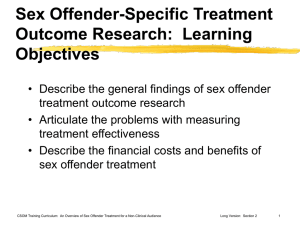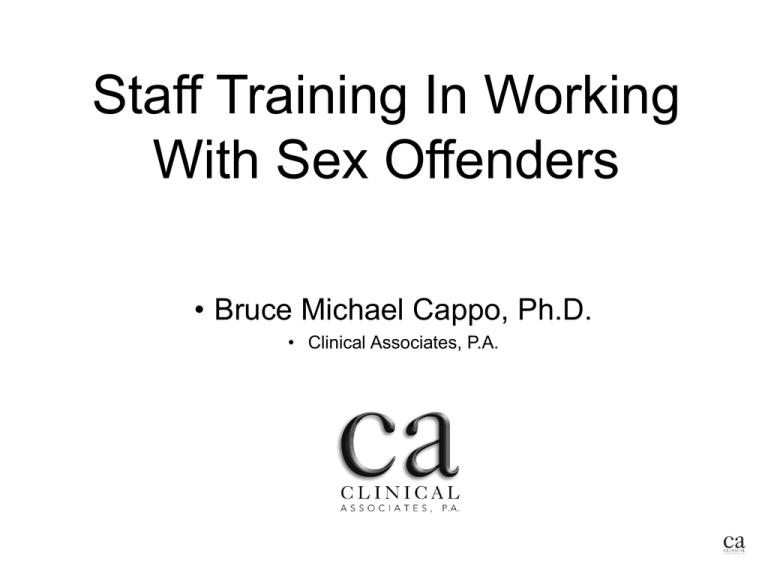
Staff Training In Working
With Sex Offenders
• Bruce Michael Cappo, Ph.D.
• Clinical Associates, P.A.
Working with Sex Offenders – Training Agenda
• Offender Characteristics
• Overview of Psychological Assessment
and Risk Assessment
• Individual Risk Factors in Supervision
• Ongoing Risk Assessment throughout
Supervision
• Offense Cycle Dynamics
• Containment Model
Rules
• Ask questions throughout
• All slides are in handouts
• Feel free to call or email after the presentation
with any questions
•
•
•
•
schlosberg@clinical-assoc.com
witcher@clinical-assoc.com
cappo@clinical-assoc.com
913-677-3553
About your presenter
•
•
•
•
•
Working with sex offenders since 1983
Johnson, Leavenworth & Miami Counties
State of Kansas Sexual Predator Transition Program
Federal Bureau of Prisons & Federal Probation and Parole
Clinical Associates, P.A.
– Multi-disciplinary group
– About 15 practitioners
• ATSA Clinical member
• Evaluation and Forensic Experience
Overview of Sex Offenders
• All socioeconomic, racial, ethnic groups
• Majority don’t present as “typical” criminal
• No ‘grab and run’ incidents
• Grooming – relationship – manipulative
• Test limits….constantly
– JP and video game, eyes closed
• Traditional adolescent issues regardless of age
CSOM Long Version: Section 1
5
Overview of Sex Offenders (cont.)
• Typically high school graduates
• More likely to be employed
• Score low risk on traditional scales
• Do not “age out” of sex offending behavior
• Only 4% have severe mental illness
(Adult Sex Offenders in Oregon, 1994; D’amora, 1999)
CSOM Long Version: Section 1
6
Relationship Between Victim and Offender (Rape in
America)
CSOM Long Version: Section 1
7
Relationship Between Victim and Offender (NVAW
Survey)
CSOM Long Version: Section 1
8
Relationship Between Victim and
Offender (National Survey of Adolescents)
Nearly 3 in 4 (74%) -- perpetrators were someone the victim knew well
Almost 1 in 3 (32.5%) -- perpetrators were friends with the victim
More than 1 in 5 (23.2%) -- perpetrators were strangers to the victim
About 1 in 5 (21.1%) -- perpetrators were family members of the victim
CSOM Long Version: Section 1
9
Location of Sexual Abuse
(National Survey of Adolescents)
30.5% in the victim’s home
23.8% in the victim’s neighborhood
15.4% at the victim’s school
CSOM Long Version: Section 1
10
Offense Cycle
• Sex offenses are planned
• Culmination of a series of events
• Offending behaviors are rationalized
• Highlights importance of reporting any unusual events or behavior
– Afterward – we look back and identify events in light of known outcome
– Attention to detail pays off
CSOM Long Version: Section 1
11
Statistics on “Cross-over”
• In one recent study, among sex offenders in this group:
– 25.7% assaulted both genders, and
– 50.0% crossed over juvenile/adult.
– Controversial and some aspects not widely accepted
(English, 1998)
CSOM Long Version: Section 1
12
Challenges to Sex Offender Supervision
• Victims assaulted in familiar places by individual they
know
• Offenders being supervised in same community where
victim lives
• Offense patterns characterized by secrecy, deceit,
repetitiveness, and extreme trauma to victims
• Cross-over offense patterns
• Fragmented response and service systems
CSOM Long Version: Section 1
13
Emerging Sex Offender Supervision Practices
• Shared, consistent philosophy, and strategy
• Primary concern for victim safety and recovery
• Prevention of future victimization
• Sex offenders held accountable for their actions
CSOM Long Version: Section 1
14
Emerging Sex Offender Supervision Practices
(cont.)
• Some offenders can be managed safely and some
cannot.
• A collaborative effort involving:
– Supervision and treatment providers,
– Victim advocates and polygraph examiners,
– All agencies with responsibility for sex offender management.
CSOM Long Version: Section 1
15
Collaboration...
• Improves communication
• Allows for quicker, less intrusive responses to victims
• Promotes the exchange of ideas among disciplines
• Facilitates sharing of information
• Improves problem solving
• Provides on-going support
• Increases understanding
• Fosters a unified and comprehensive approach
CSOM Long Version: Section 1
16
How a sex offender evaluation figures into
subsequent supervision issues
•
•
•
•
•
•
•
•
•
•
•
•
•
•
•
Intellectual
Educational
Overall Function
Personality and Mental Health
Social
Developmental
Family
Current Status
Sexual Issues
Delinquency and Conduct
Risk Assessment
Risk and Protective Factors in the Community
Awareness of Victim Impact
Relapse Prevention Resources
Amenability to Treatment
Juvenile Risk Assessment Measures
• ERASOR II- Estimate of Risk of Adolescent Sexual Offense
Recidivism
• J-SOAP II – Juvenile Sex Offender Assessment Procedure
• J-RAT – Juvenile Risk Assessment Tool
• Older Adolescents – SORAG Sex Offense Risk Assessment Guide
• Older Adolescents – VRAG Violence Risk Assessment Guide
• Psychopathy Check List - Youth Version – PCL-YV (special
training needed)
Adult Risk Assessment Measures
• SORAG Sex Offense Risk Assessment Guide
• VRAG Violence Risk Assessment Guide
• Psychopathy Check List II - PCL-II (special training needed)
• STATIC 99
• RRASOR – Rapid Risk Assessment for Sex Offense Recidivism
• MnSORT-R – Minnesota Sex Offender Screening Tool – Revised
• SONAR – Sex Offender Needs Assessment Rating
• Relevant Research and Other Resources
6 types of methodologies
• Unguided clinical judgment
• Guided clinical judgment
• Clinical judgment based on anamnestic
(medical history) approach
• Research guided clinical judgment
• Clinically adjusted actuarial approach
• Purely actuarial approach
Purely actuarial approach
•
•
•
•
Most mechanical approach
Actuarial instruments with no adjustments
Consistent results
Can be utilized by non-professionals or paraprofessionals with training
• This is what we are here for today
• You will be able to employ these methods
based on your training today
Clinical vs Actuarial
• Studies of sex offenders and
recidivism risk
• Two Meta-Analyses
• Same conclusion
• “Mechanical predictions of human
behavior are equal or superior to
clinical prediction for a wide range of
circumstances” Grove 2000
A ccuracy of C linical and A ctuarial P rediction
of S ex O ffense R ecidivism
0 .3 5
0 .3
0 .2 5
0 .2
r
c lin ic a l (a -j)
0 .1 5
a c tu a ria l (k -m )
0 .1
0 .0 5
0
-0 .0 5
a
b
From Dr. Hanson
c
d
e
f
g
h
i
j
k
l
m
Clinical Judgment is Inadequate
• Empirical tools significantly and consistently surpassed
clinical judgment – Grove and Meehl 1996
• Despite seven decades of findings about the superiority
of actuarial methods over clinical opinion, clinicians
remain reluctant to replace their judgment with scientific
tools
• The tools we have are not perfect but they are getting
better all the time and they surpass clinical opinion
Group Statistics Versus the Individual
• Potential problems and errors
Evaluation and Supervision Issues
• A good evaluation addresses all of the
following issues on the upcoming slides
• Supervision is impacted, limited and facilitated
as a result of where the offender falls in these
areas
• Understanding of the relationship between
such information and the subsequent
requirements directly impacts compliance
Intellectual and Educational
•
•
•
•
Capacity of the offender = intelligence
Formal academic completion = educational achievement
There may be a great disparity between the two
A bright offender is likely to be even more devious and
create situations allowing for benefit of the doubt
• This may be unrelated to his formal education level
• In general, higher risk comes from either end of the
spectrum
• Persons at the lower and upper extremities are considered
higher risk than those in the middle
Overall Function - Personality and mental health
• The higher functioning the better in terms of
compliance issues
• Having a high degree of function allows one to drive
over the bumps in the road without ending up in the
ditch
• Dealing with other factors of stable living increase
risk that they will offend as a coping response
• When coping responses are stretched thin, they are
most vulnerable
• A personality disorder diagnosis or diagnosis of a
severe and persistent mental illness increases risk
of re-offending
Social, Developmental, Family
• These factors relate to one’s resiliency
• They also address issues of support which may
decrease risk
• A socially adept or facile offender may present
greater risk in terms of opportunity and success
• Treatment focus may need to address particular
developmental issues such as adultification at a
young age or developmental stagnation
• Family may be a hindrance or a help
Current Status
• What are the static versus dynamic variables
• Is risk likely to increase or decrease over time
• Does the supervising officer influence or control
variables that impact this?
– Where or with whom he lives - yes
– Stability of present job - probably not
– Health issue in offender or relative - no
• Staff should watch for variables / changes that are
identified as impacting status
– Current relationship
• Recent breakup
Sexual Issues
• Has offender been married or in appropriate
relationships - if so this decreases risk
• What is his current status
• Monitoring relationships with access to
children
• Focusing therapy on relevant topics specific to
the offender
Delinquency and Conduct
• Risk of continued non-sexual legal
involvement
• Risk as a function of decision making
and other life consequences
• Even though there is a sexual offense
- general rules of supervision still hold
Risk Assessment,
Risk and Protective Factors in the Community
• Current risk level
• Static and dynamic factors
• Watch for changes in identified
protective factors
–Parent, spouse or mentor change
such as illness or relocation
Awareness of Victim Impact
•Significant variable
•Ongoing recognition vs able to
say the right thing
•Role as a deterrent for future
behavior
Relapse Prevention Resources &
Amenability to Treatment
• Resources available in the community
• Willingness to access resources
• Commitment to treatment
• Ability to benefit from treatment
–IQ, predator status
• Acceptance of problem and treatment
Sex Offender Risk Assessment
• Static (unchangeable)
– Prior sexual offenses
– Age
– Any extrafamilial victims
• Dynamic (changeable)
– Stable
• Marital status
• Deviant sexual preferences
• Personality disorders
– Acute
• negative mood
• drunkenness
Insert Age figure here
“Percentage of accused”
VRAG - Violence Risk Assessment Guide
• Probably best measure for classifying reoffense risk of
violent offenders
• Only a few items different between VRAG and SORAG 12 items
• Requires a thorough and reliable social history, knowledge
of the offender’s DSM diagnosis and a PCL-R score
SORAG - Sex Offense Risk Assessment Guide
• A variation of the ”Violence Risk
Appraisal Guide” (VRAG)
• Effective though relatively complicated
14-item scale
• Requires a thorough and reliable
social history, knowledge of the
offender’s DSM diagnosis and a PCLR score
SORAG
• SORAG may be the best currently available instrument for
classifying reoffense risk among violent sexual offenders
but appears inferior to other instruments (RRASOR,
Static-99) for classifying risk of non-violent offenses often
more typical among child molesters
Hare Psychopathy Check List - Revised PCL-R
• Special training needed through Darkstone - Dr.
Hare’s educational company
• Measure of psychopathy - a construct
• NOT a measure of antisocial personality disorder
from DSM IV
• Scored as part of SORAG and VRAG
• Percentile rankings and T-scores available for both
institutionalized and parole populations
• Britain dictates that incarcerated inmates who score
above a cutoff will not be given treatment as they
will not benefit - upheld by their courts
Factors Associated with a New Sex Crime
• Sees self as no risk
• Access to victims
• Attitudes tolrant of child molesting
• Uses general excuses / justifications
• Low victim empathy
• Attitude of sexual entitlement
Sex Offenders who Failed on Supervision
• View themselves as not being a risk
• Had diverse victim types
• Spent fewer months in the community
• Had access to victims
• Higher sense of sexual entitlement
• Poor social influences
Using Assessment in Supervision
• PCL-R
–Predicted general and serious recidivism
• MnSOST-r
–Predicted general recidivism
Recidivism
• Barbaree, Seto, Langton & Peacock Criminal
Justice and Behavior, 2001
• All received SO treatment
• 215 offenders followed for an average of 4.5 years
• 38% recidivate for any offense
• 24% recidivate for serious offense
• 9% recidivate for sexual offense
Treatment progress and predicting
recidivism
•Positive treatment behavior was
associated with greater risk of
reoffending for those with high
PCL-r scores
Risk assessment is ongoing
• Risk is not stable over time
• Denial occurs on a continuum
–Denial of the act
–Denial of the fantasy
–Denial of the responsibility
–Denial of the seriousness
–Denial of the impact
–Denial of true risk level
Low vs High Risk
• Accuracy of prediction increases as rate of
occurrence increases
• High frequency events are easier to predict
than low frequency events
• Low risk may not be in actuality low risk
–Specific factors may be useful here
• Polygraphs aid in treatment and in ongoing
assessment of risk
Specificity and Recidivism
• Kim English – paraphrased – If Coke is not available
then they will drink Pepsi
• Crossing over is natural and expected
• When pictures are inadequate then they progress to
touching
• Data is controversial
• Certainly some will and do cross over
• However, some persons will drink nothing if Coke is not
available
• Not everyone engages in homosexual acts in prisons
despite a lack of preferred gender partners
Specificity and Recidivism
• You must know what is prioritized and what is restricted for that
individual
• If dying of thirst then might drink alcohol in the desert
• If there are no boundaries or weak boundaries then cross over
might be easier
• Some will never cross over
• Some have no boundaries and there is nothing to cross
• Management of offenders needs to take into account such
differences in terms of risk
• Can an offender have contact with daughter now that she has
reached puberty and is not in his target? It Depends.
Does Treatment Work?
• Depends on who you ask, how you ask and how
they slice the data …but it can reduce recidivism
• Recidivism rates over 5 years in Colorado n=1585
• No Treatment – 47% recidivism rate
• Phase 1 Treatment – 30% recidivism rate
• Phase 1 & 2 Treatment – 15.7% recidivism rate
• Differences are statistically significant
• Phase 2 is therapeutic community
Offense Cycle
• The specific details of events, thinking errors, feelings,
goals, and behavior which preceed, occur during, and
follow a sexual offense
• Sexual offense behavior is viewed as a middle step in
predictable sequence of repeating maladaptive
behaviors.
• Feeling victimized by a sense of betrayal, helplessness or
powerlessness appears to be the first step in this cycle,
followed by a predictable pattern of maladaptive and
acting-out behaviors which precede the sexual offense.
Offense Cycle
• There are also post-assault behaviors, thinking errors,
goals and feelings which are predictable and repetitive,
and which conclude the final step of the cycle - that of
the offender feeling "okay" in his/her world.
• Generic versus specific for each offender
• They must learn their own cycle as part of the treatment
process
• Journals are tied back to offense cycle events
Dynamics of Offense Cycle
• Within the repeated sequence of predictable
maladaptive feelings and behaviors exists a potent
dynamic for change called recycling.
• It is a predictable departure from a series of
predictable behaviors, and a re-entry to the
beginning point of cycle prior to an assault.
• It is a dynamic of self perpetuating stress. The
offender is dysfunctionally failing to meet personal
needs in mid-cycle and before the assault.
Dynamics of Offense Cycle
• The offender experiences feeling re-victimized by nonvictimizing events and starts back through cycle another
time.
• Each repetition through an incomplete assault cycle,
through return to a repeated sequence of thinking errors,
feelings and behaviors serves to decrease esteem and to
increase the offender's practices to self protect in ways
which exclude and increasingly exploit the rights and
needs of others.
• The process appears to escalate objectifying others,
viewing others as objects.
Dynamics of Offense Cycle
• Recycling functions as a build up of increasing
internal frustration and pressure.
• This pressure may be vented by acting-out
behaviors or by fantasy of getting back at others.
• Initially get-back fantasies serve as a pressure
reducer.
• Recycling desensitizes the individual to the initially
high degree of pressure release achieved by fantasy
or acting-out behaviors.
Dynamics of Offense Cycle
• Repeating get-back fantasy as a maladaptive form of
problem resolution, pressure release, or discharge of
anger or hurt may subsequently decrease in desired
effect.
• Effectiveness is lowered over time – like tolerance for
addicts – they need more to reach same levels
• Fantasy may need to become increasingly sensational,
intrusive or exploitive in order for the individual to
continue to derive the same rush or relief.
• Fantasy translates to action.
Logistics
• Awareness of Cycle – Offense Patterns – Early Signs
•
•
•
•
•
Familiarity with offender’s schedule and whereabouts
Encourage application of treatment tools outside therapy
Working closely with treatment provider
Acknowledge seriousness of offending behaviors
Hold offender accountable early in the onset of risky
behaviors
• Report non-compliance to treatment providers
Containment Approach
• Victim orientation
• Multidisciplinary collaboration
• Containment strategy
• Informed policy
• Quality control
Victim Orientation
• From pre-trial to post-conviction
through supervision
• What’s best for the victim
–Children need protection
–Adults need empowerment
Collaboration
•
•
•
•
•
•
•
•
•
•
Law enforcement
Child protection
Rape crisis centers
Prosecuting attorney
Probation and parole
Treatment providers
Polygraph services
Prison staff
Judges
School staff, medical staff, victim advocates
Containment Strategies
• Criminal Justice
• Treatment Staff
• Polygraph
Supervising officer
• Intensive supervision with small caseloads
• Seek and respond to information
• Provide the ‘hammer’
• Provide corroborative information
• Response is linked to risk
Treatment Providers
•
•
•
•
•
•
•
•
•
Sexual history
Specific issue polygraphs
Maintenance polygraphs (every 6 months)
Accountability focus
Consequences for not following directives
Emphasize that everything is a choice
Verify behavior change externally
Confidentiality limits
transparency
Polygrapher
• Develop working relationship as member of
the team
• Timely reports – fast feedback if action
needed
• Input in developing specific issue questions
Informed Policies
• Research based
• DA policies of agreements and pleas in sex cases
• Acceptance of sex offenders in denial for both
community supervision and treatment
• Limited immunity to offenders who reveal additional sex
crimes during treatment / polygraph process
– Antelope 9th circuit decision – polys cannot be used to
circumvent 5th amendment right to not self-incriminate
• Selection criteria for treatment providers
Quality Control
•
•
•
•
•
•
•
•
Frequent training
Understanding of job impact on community
Adequate supervision
Standards for practice
Risk assessment
Regular meetings
Individual treatment approach
Measures of progress
Time For Your Questions
• Bruce Michael Cappo, Ph.D.
• Clinical Associates, P.A.

